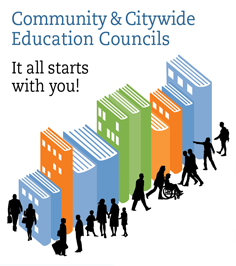Citywide Council On High Schools (CCHS)
What does the CCHS do?
- Advises and comments on educational or instructional policies involving students in high school.
- Issues an annual report on the effectiveness of the city district in providing services to students in high school.
- Holds at least one meeting per month open to the public during which the public may discuss issues facing students in high school.
How many members serve on the CCHS?
- Ten (10) parents (two from each borough, with children who currently attend a public high school in the borough that the parent represents);
- One (1) member appointed by the Citywide Council on Special Education;
- One (1) member appointed by the Citywide Council on English Language Learners;
- One (1) member appointed by the Public Advocate; and
- One (1) non-voting high school senior who is an elected leader at his or her school.
When is eligibility determined?
Eligibility is determined as of the date that the parent submits an application to run for a position on the CCHS.
Which borough would I be eligible to represent on the CCHS?
Eligible applicants will appear on the ballot for the borough in which their child currently attends high school.
What if I have current high school students in multiple boroughs?
Eligible applicants who have children who attend public high schools in different boroughs shall appear on the ballot for each borough where the applicant’s children attend high school. Applicants must rank on their application, in order of preference, which borough they’d like to represent. If selected, the applicant will represent the borough that they’ve ranked highest.
How and when can I apply to serve on the CCHS?
During the 2013 Selection Process, you can apply to serve on the CCHS HERE (on or after February 13, 2013). The application process ends at 11:59 on March 27th. For those lacking access to a personal computer, the Division of Family and Community Engagement (FACE) will provide information regarding how individuals may access computers at FACE’s office, in local district offices and schools, and at public libraries.



